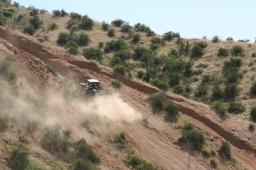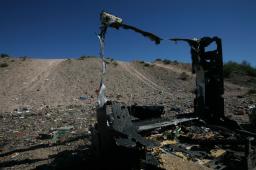- Slug: BC-CNS-OHV Education,440
- With: BC-CNS-OHV Education-Box
- File photos available (thumbnails, captions below)
By TRAVIS GRABOW
Cronkite News Service
PHOENIX (Wednesday, Sept. 16) _ A new booklet summing up Arizona’s off-highway vehicle laws and offering tips for responsible riding is an important step in preserving the sport here, a state lawmaker says.
“There’s a lot of people that aren’t paying attention to our environment that are just going out and blazing up new trails everywhere,” said Rep. Jerry Weiers, R-Glendale, author of a broad law applying to OHV use that took effect this year. “And that makes environmentalists unhappy, and they start forcing trails to close down.”
The booklet, produced by the Arizona Game and Fish Department and Arizona State Parks, is available at the offices and Web sites of those agencies as well as at many riding areas around the state and at many OHV dealers. The agencies previously printed separate brochures.
As of 2002, more than 1 million people reported being OHV enthusiasts, spending an average of 25.4 days per year riding, according to an Arizona State University study.
Riders who don’t stick to designated trails create scarred landscapes, an especially severe problem in desert areas.
An important part of the solution is getting OHV enthusiasts the information they need to ride responsibly and ethically, said Jim Harken, a Game and Fish spokesman.
“If we can educate the public about the correct way to be out there, the correct way to do their riding, the better it is and the more access we will be able to keep open for all those people,” he said.
Worried that OHV damage would close areas to riders, Weiers, supported by a broad coalition including OHV groups, environmentalists, the National Rifle Association and others, shepherded legislation that became law Jan. 1.
One provision requires riders to pay a $25 annual registration fee for their vehicles. Money from those fees is intended for clearly marking trails, providing more enforcement of OHV laws and educating riders through means such as the new booklet.
The law also requires riders to stick to designated trails and makes certain types of riding illegal, such as damaging wildlife habitats, property or cultural or natural resources.
Weiers said that educational materials such as the new booklet can help prevent that from happening and ensure that trails stay open to responsible OHV use.
“The bottom line is we want education to be up front,” he said.
Educating riders about where they can ride is one of Arizona State Parks’ most important contributions to the booklet, said Amy Racki, the agency’s OHV coordinator.
“The biggest message anyone can take home from this brochure is our slogan, written on the bottom of the pamphlet, which is, ‘Nature Rules! Stay on Roads and Trails.'”
Jeff Gursh, executive director of education, grants and agreements for the Arizona OHV Coalition, among the rider groups that pushed for the new law, said offering essential information in one place is an important step.
“We want to continue to have access to public lands, but we want it to be managed responsibly,” he said. “We want to take all the complaints and excuses people have and take them away.”
^___=
Web Links:
_ Game and Fish Department: www.azgfd.gov
_ Arizona State Parks: www.azstateparks.gov
_ Arizona OHV Coalition: www.azohvc.com
^___=
PHOTOS: Click thumbnails to see full-resolution images.

In this April 2008 photo, an off-highway vehicle rides on an illegal trail in the Tonto National Forest near Mesa. A new booklet produced by the Arizona Game and Fish Department and sums up OHV laws and offers tips for responsible riding. (Cronkite News Service Photo by Nora Avery-Page)

In this October 2008 photo, the Tonto National Forest near Sycamore Creek northeast of Phoenix shows damage and erosion from illegal off-highway vehicle use. Officials say the key to cutting down on environmental damage from illegal OHV use is getting operators to embrace the reasons they should remain on trails. (Cronkite News Service Photo by Deanna Dent)

In this April 2008 photo, an area of the Tonto National Forest near Mesa shows scars from illegal riding by off-highway vehicle users. Officials say the key to cutting down on environmental damage from illegal OHV use is getting operators to embrace the reasons they should remain on trails. (Cronkite News Service Photo by Nora Avery-Page)